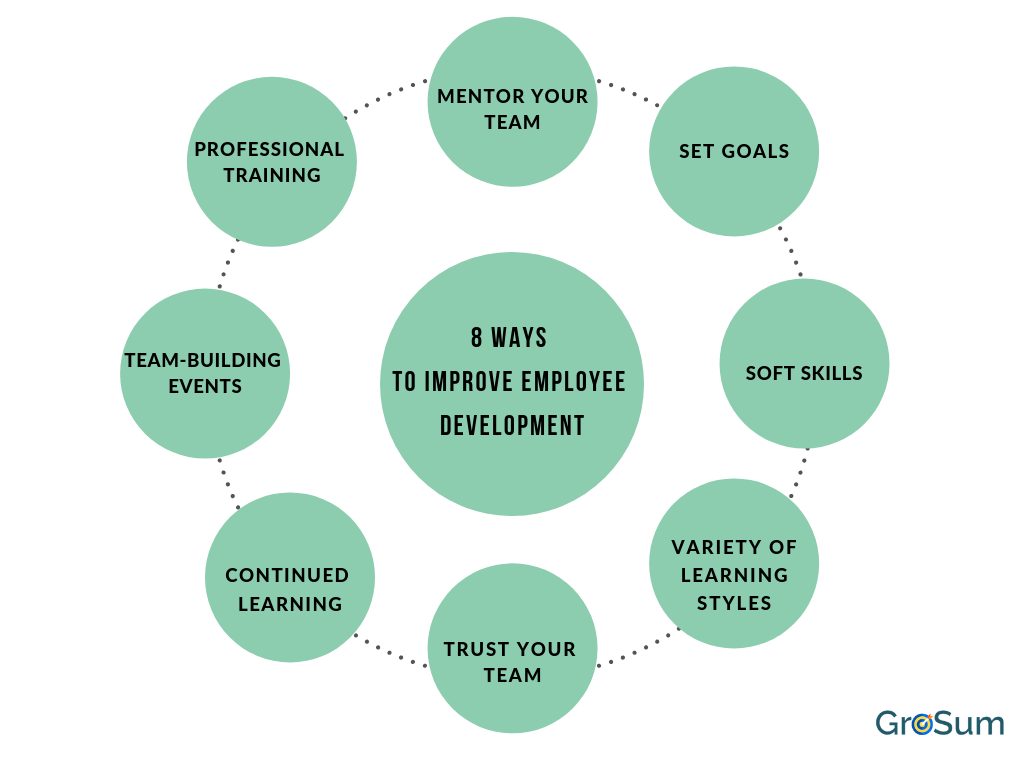
Whether you’re just starting out or have been in business for quite a while, growing your company is not an easy task to take on. You have many factors that influence the growth (or lack thereof) of your business. It’s a challenge deciding where to focus your time.
One factor of any company that can easily find it’s way at the bottom of the list is employee development. However, employee development is one aspect that should always be of top priority.
Employees are what help run the business. In many circumstances, without having employees around, the company would not move forward. To keep your staff happy and thriving, developing their skills is crucial. So, take a look at the following eight ways that you can help improve employee development at your company.

Use Professional Training
Although this isn’t always the case for every company, professional training is one of the best ways to improve employee development. It could be something you create yourself and work with your team, or it could be that you outsource this training to a company that specializes in employee development.
Mentor Your Team
Mentoring your team is a crucial step in employee development. What better way for your staff to develop into the employee that you’re looking for, than to have you, the boss, mentor them?
Passing on your skills and knowledge that helped you get to where you are today is invaluable information that your employees would deeply benefit from. Learning how to coach your staff both as a team and on an individual basis will continue to enhance their development.
When mentoring, it’s important to know the difference between encouraging and micro-managing. Employees don’t want their boss hovering over their shoulder every moment of the day. As a mentor, you still need to give them room to grow on their own. Part of the mentoring process will be allowing the employee to make a mistake and learning from it together.
Include Team-Building Events and Exercises
Team-building exercises promote employee development at a different level – learning to bond and work with your team to succeed.
Think of activities that your staff members would need to work together in order to meet the goals. Encouraging your staff members to work together will enhance their communication skills and allow them to learn more about each other, which could become an asset in the office.
Team-building doesn’t have to be solely in the office and working. It can also include taking your employees out for snacks on a Friday afternoon or having a retreat that allows them to relax and let loose. The purpose of team-building is to find ways for your employees to connect with one another so that it transfers into their work ethics.
Focus on Soft Skills
We often forget about employees’ soft skills and how important they are. Soft skills are the people skills that employees possess. It can be anything from empathy and listening skills to adequate communication. These skills are critical for every employee to master.
Paying attention to soft skill development will help shape the workplace environment overall. Imagine working with a team that cannot communicate with each other, disconnected from their work, and argue over the smallest hiccup throughout the day. Now, compare that to a workplace filled with employees who bounce ideas off of one another, encourages each member, and can stay on task. Developing soft skills will help shape your office environment to resemble the latter example.
Invite coaches that specialize in soft skills training to work with your team. Look for things that help with reading body-language, non-violent communication, self-awareness, and empathy toward other people.
Promote Continued Learning
It doesn’t matter what age you are, there is always room to continue learning. Many skills that employees currently possess will continue to evolve. It’s essential that everyone keep up with the changing world.
Offer training through your company. It could be coaching from you, learning about another aspect of the company through cross-training, or having online classes available to further the skills required for their job.
Set Goals and Milestones
Goals and milestones are an excellent motivator to keep employees productive. For many people, being able to check off a goal from their list is a way to keep pushing them throughout the day. Not only that, but it also encourages employees (and yourself) to stay organized.
Using this tactic is an excellent means of accountability for both employees and management. There is a difference between goals and milestones, though, that is important to remember. Goals are what you’re trying to achieve. They could be individually based or for the entire company. Either way, a goal is the end result of your hard work.
Milestones, on the other hand, are the steps you take to achieve said goal. They tend to be smaller as they are the building blocks to your goal. Milestones are an excellent motivator for the goal put in place. When mixed together with goals, both of these options work well to keep the team focused, disciplined, and productive.
Show You Trust Your Team
Want to really motivate your employees and keep them productive? Show that you trust them to do the job you hired them to do.
Micromanaging your staff or doing all the work for them won’t get you very far. For starters, it takes up more of your time that you could spend doing your job. Not only that, but when employees feel trusted by their boss, it’s an empowering feeling, and they won’t feel the need to spend precious time having you check over their work.
Having trust in the workplace also leads to respect between employees and management. Respect goes a long way in the workplace, and it’s often noticed in productivity levels and the quality of work. If you don’t believe that your employer trusts you with your job, how motivated would you be to get your work done on time and to the best of your ability?
Show that you have faith in your employees by letting them do their job. You’ll soon notice that not only will they get their work done, but that they are happy to do it.
Offer a Variety of Learning Styles
Not everyone learns the same way. Some people are more visual than others while someone else needs a manual to follow. Offering different learning styles to your employees will allow them to use a method that is best suited for them. When you learn through a comfortable learning style, you’re more likely to catch on faster and remember what you need to know.
There are four main learning styles you’ll often find:

- Visual and verbal – think of how a student learns in a classroom through notes and visuals.
- Independent – this person thrives when given the material and left to learn at his or her own pace.
- Conversational – discussing the content back and forth is best for this type of learning.
- Hands-on – problem-solving and physically going through the steps.
Offer these four learning styles to your employees for each individual to succeed. It may take some trial and error to determine the best route to take. However, you’ll notice a difference in each person when they’re matched with the correct learning style for their needs.
Furthering employee development will not only benefit your company, but it will also benefit the employee. One of the top reasons for an employee to quit is lack of employee development. Encourage your staff to remain by always giving them opportunities to grow as a worker, and as a person.
[…] to be short and most of it should be said in person. It’s not intended to serve the purpose of formal development for the upcoming year but more as a way to show them what they can do. It’s a launching point for […]
[…] Employee development is a key factor in improving company culture and achieving your goals. Your employees shouldn’t feel stagnant—they should be learning continuously, either on the job or outside the office. […]